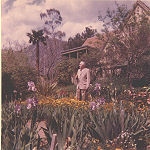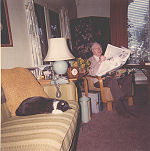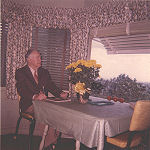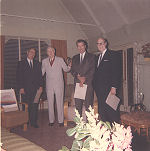 |
firm active: 1907-1921 minneapolis, minnesota :: chicago, illinois |
Biographical Notes: William Gray Purcell (1880-1965)
Biographical essay in Guide to the
William Gray Purcell Papers.
Copyright by Mark Hammons, 1985.
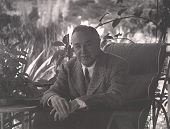
WESTWINDS, 1936-1965
Situated on a hilltop with a sweeping valley view, the southern California estate to which Purcell and his second wife moved in 1936 came to be known as Westwinds. There Purcell created a lushly landscaped retreat and established a pleasant but well monitored routine that permitted him to work despite a continuing semi invalid condition. Over the next thirty years he produced a vast array of manuscripts and publications, conducted a voluminous correspondence, and engaged in many philanthropic interests. The achievements of his retirement years could easily have been the lifework of a lesser man, but to Purcell these efforts were a pleasure as well as his social responsibility.
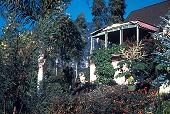 Westwinds, circa 1960
Westwinds, circa 1960
The years at Westwinds were marked by a peaceful and happy family life that had
eluded Purcell in earlier times. His delicate and intelligent wife Cecily was a
loving companion who thoughtfully watched her husband for signs of overwork and
insisted on regular periods of relaxation that they spent together on the
backyard lanai. During World War II, two nephews of Cecily Purcell sent to
America to avoid the bombing in England came to stay with the Purcells, who were
joyous to have children at the house. When the young men went home in 1946,
Cecily's sister Dorothy O'Brien came to live at Westwinds following her release
after the war from the British intelligence service. The longtime employment of
several household staff members gave an added sense of extended family.
Throughout the Westwinds period, Purcell took every opportunity to further the
ideals of the philosophical cause with which he had always kept faith. Writing
was a principal activity, and two projects were of special importance. From the
late 1930s to the mid 1950s, Purcell developed a series of unpublished essays
called "The Parabiographies" that were commission by commission accounts of
experiences during his architectural practice. These pages, together with many
manuscripts discussing Sullivan and the "function and form" thesis, were sent
for reading to George Elmslie who often added his own annotations.
From 1940 to 1955, Purcell was principal contributing editor to an architectural
journal, Northwest Architect, to which he contributed more than sixty articles.
Directed to a popular readership as well as his professional audience, these
writings represent the most complete presentation of his architectural
understanding. Purcell revived the intentions of the progressive movement by
applying the organic principles to such diverse topics as, for example, city
planning, advertising, and movie making, and often used his own life experiences
as subject matter to illustrate the universal and continuing influence of
architecture on human activities.
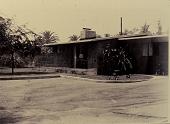 |
Prospect Avenue houses South Pasadena, California 1946 James Van Evera Bailey, associate architect |
As well as talking about architectural theory, Purcell continued to experiment
with architectural techniques in houses that he built as rental properties.
During the late 1940s he was much concerned with the post World War II housing
shortage and erected various groups of houses that employed experimental
structural techniques. Designed in 1946 in association with James Van Evera
Bailey, two flanking concrete houses with reversed floor plans tested an
innovative form of slip-form construction and a simplified heating system. The
basic enclosure of each dwelling of a larger group of speculative houses,
collectively known after the developer who built them as the Sapperstein
project, was completed within a week using a quick construction principles
originated by the John B. Pierce Foundation. The last major commission in which
Purcell took personal credit as architect was the K. Paul Carson residence,
built in 1940 in Edina, Minnesota. Carson was the son of a former Purcell &
Elmslie client who had rejected a house proposed by the firm in 1920. With
drawings and consultation by Frederick A. Strauel, the design of the house
continued to evolve over a number of years through extensive correspondence
between the Carsons and Purcell.
Since he could not travel, Purcell maintained his relationships largely through
correspondence. He remained in frequent touch with artist friends such as
Richard Bock, Charles S. Chapman, Frederick D. Calhoun, and Clayton S. Price. He
renewed personal and family relationships that had lapsed during his illness,
often by sending a small audio recording known as a Soundscriber disk. For
research related to his writing projects, he contacted former associates,
clients, and old friends who often gladly replied to his questions. Along the
same lines, Purcell wrote to architects or their relatives, such as Roger Berry,
brother of Parker N. Berry, who had worked in the Sullivan office following the
departure of Elmslie, and other architects from the progressive movement like
Frances Barry Byrne and Marion Mahoney Griffin.
Many students, architects, and architectural historians wrote to Purcell, who
usually answered their questions with lengthy manuscripts as well as letters and
dictated audio recordings. For instance, he was a major influence on Willard
Connely as the writer developed his biography of Louis Sullivan, and he
corresponded with Maurice English in the development of another book on Louis
Sullivan. Purcell was often contacted by architects about to do work on Purcell
& Elmslie buildings, and he also maintained a warm friendship with architectural
photographers Wayne Andrews, John Szarkowski, and Richard Nickel.
When well enough to receive guests, Purcell opened Westwinds with a warm
hospitality. Visitors included Tadeus Janowski, a Polish born architect, and
Gosta Edberg, a Swedish architect who initiated the experiments that resulted in
an art form Purcell called the "chromograph." Some friends from the past lived
nearby. By coincidence, Lawton S. Parker came to live in Pasadena after his
chateau was confiscated during the Nazi occupation of France. Douglas Donaldson
was working as a movie set designer in Hollywood and often visited Purcell.
Erven Jourdan, the son of Portland photographers Albert and Alda Jourdan, came
to live in Los Angeles during the 1940s, and Purcell was instrumental in
starting the young man's career as a photographer. Purcell bought cameras and
other equipment for Jourdan and began a series of projects. He was particularly
interested in the preservation of architectural history and underwrote the costs
of what was probably the first true architectural cinematography, Southern
California Houses of Frank Lloyd Wright.
Another major accomplishment was the conscious preservation of his own
documents. The richness of the archives that John Jager had so carefully
preserved was first displayed to the public in an exhibition called "Purcell &
Elmslie, Architects" at the Walker Art Center in Minneapolis, Minnesota, in
1953. Although there had been a smaller presentation of selected records by the
University of Minnesota Art Department a year earlier, the Walker show entailed
a deeper and more thorough examination of the Purcell & Elmslie archives than
ever before.
At the personal request of Purcell, Jager received visiting art historians from
the Walker and the university in his home where the records were stored.
Graduate students Eileen Manning and David S. Gebhard, already known to Jager,
accompanied professors Donald Torbert and Dmitri Tselos, who were impressed by
the wealth of documentation. Shortly afterwards, a university vice president,
Malcolm Wiley, wrote to Purcell to express the institution's interest in
acquiring the materials. The director of the Walker Art Center, H. H. Arnason,
also contacted Purcell to say that donation of the archives to the university
would be a great gift to the scholarly world.
In the early 1960s, Purcell was nominated to the College of Fellows of the
American Institute of Architects. James Van Evera Bailey was instrumental in
bringing the award to his former teacher and associate, and Purcell reluctantly
agreed to the honor in hopes of bringing to light once more the progressive work
done by Purcell & Elmslie. Since Purcell was too weak to travel, the award was
presented by a special committee that called at Westwinds in the summer of 1963.
By the time of his fellowship, Purcell had survived most of his contemporaries.
John Jager died in 1959 and Cecily Purcell passed away a year later. Realizing
his time was short, Purcell put aside all other projects to concentrate on a
collection of stories at which he had been at work sporadically since the 1920s.
Titled St. Croix Trail Country, the vignettes recollected the life he had known
as a child at Island Lake, Wisconsin. Filled with charts, diagrams, maps, and
illustrated with original photographs, the book appeared posthumously in 1966.
This publication was the final fruition of Purcell's labors, a last reflection
sent forth to bring the democratic, organic spirit into the lives of those who
would follow.
